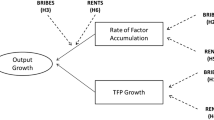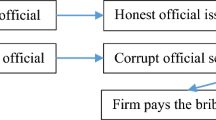Abstract
Using a nationwide survey of provincial institutional quality and a sample of private manufacturing small and medium scale enterprises (the SMEs), this paper contributes to the literature by considering for the first time the effects of corruption on the financial performance of Vietnamese private SMEs. Interestingly, contrary to previous findings, we find that corruption when measured by a dummy variable, does not affect firms’ financial performance after controlling for heterogeneity, simultaneity and dynamic endogeneity. However, the intensity of bribery and the majority of the forms of corruption were found to have negative impacts on firms’ financial performance. Hence, a typical approach using only a dummy variable for bribery might not adequately evaluate the impact of bribe intensity or even ignores the negative impacts of some types of bribes on firms’ financial performance. The findings suggest that anti-corruption measures are vital for the development of the Vietnamese private SMEs.
Similar content being viewed by others
Notes
Time tax reflects the required time that the managers of firms spend complying with government regulations (De Rosa et al. 2010).
The World Business Environment Survey interviewed managers from more than 9000 firms in 1999–2000. Respondents were asked: “is it common for firms in your line of business to have to pay some irregular “additional payments” to get things done?”.
The definitions of these sub-indicators are presented in Appendix Table 5.
After replacing bribe by bribe intensity or types of corruption, negative and significant relationships between bribe intensity or types of corruption with firms’ financial performance are also observed.
References
Ades, A., & Di Tella, R. (1996). The causes and consequences of corruption: A review of recent empirical contributions. IDS Bulletin, 27(2), 6–11.
Bai, J., Jayachandran, S., Malesky, E. J., & Olken, B. A. (2013). Does economic growth reduce corruption? Theory and evidence from Vietnam: National Bureau of Economic Research.
Blundell, R., & Bond, S. (1998). Initial conditions and moment restrictions in dynamic panel data models. Journal of Econometrics, 87(1), 115–143.
Bond, S. R. (2002). Dynamic panel data models: A guide to micro data methods and practice. Portuguese Economic Journal, 1(2), 141.
Cheung, Y. L., Rau, P. R., & Stouraitis, A. (2012). How much do firms pay as bribes and what benefits do they get? Evidence from corruption cases worldwide. Cambridge: National Bureau of Economic Research.
De Jong, G., Tu, P. A., & Van Ees, H. (2012). Which entrepreneurs bribe and what do they get from it? Exploratory evidence from Vietnam. Entrepreneurship Theory and Practice, 36(2), 323–345.
De Rosa, D., Gooroochurn, N., & Gorg, H. (2010). Corruption and productivity: firm-level evidence from the BEEPS survey. World Bank Policy Research Working Paper Series, No.1632. Kiel institute for the World Economy. Kiel, Germany.
Donadelli, M., Fasan, M., & Magnanelli, B. S. (2014). The agency problem, financial performance and corruption: Country, industry and firm level perspectives. European Management Review, 11(3–4), 259–272.
Faruq, H., Webb, M., & Yi, D. (2013). Corruption, bureaucracy and firm productivity in Africa. Review of Development Economics, 17(1), 117–129.
Fisman, R., & Svensson, J. (2007). Are corruption and taxation really harmful to growth? Firm level evidence. Journal of Development Economics, 83(1), 63–75.
Flannery, M. J., & Hankins, K. W. (2013). Estimating dynamic panel models in corporate finance. Journal of Corporate Finance, 19, 1–19.
González, V. M. (2013). Leverage and corporate performance: International evidence. International Review of Economics & Finance, 25, 169–184.
Halkos, G. E., & Tzeremes, N. G. (2010). Corruption and economic efficiency: Panel data evidence. Global Economic Review, 39(4), 441–454.
Halpern, L., Koren, M., & Szeidl, A. (2005). Imports and productivity. Retrieved from http://papers.ssrn.com/sol3/papers.cfm?abstract_id=785127.
Hoskisson, R. E., Eden, L., Lau, C. M., & Wright, M. (2000). Strategy in emerging economies. Academy of Management Journal, 43(3), 249–267.
Hung, H. (2008). Normalized collective corruption in a transitional economy: Small treasuries in large Chinese enterprises. Journal of Business Ethics, 79(1–2), 69–83.
Jain, A. (2001). Corruption: A review. Journal of Economic Surveys, 15(1), 71–121.
Kasahara, H., & Rodrigue, J. (2008). Does the use of imported intermediates increase productivity? Plant-level evidence. Journal of Development Economics, 87(1), 106–118.
Koellinger, P. (2008). The relationship between technology, innovation, and firm performance: Empirical evidence from e-business in Europe. Research Policy, 37(8), 1317–1328.
Lau, C. K. M., Demir, E., & Bilgin, M. H. (2013). Experience-based corporate corruption and stock market volatility: Evidence from emerging markets. Emerging Markets Review, 17, 1–13.
Le, C. L. V. (2010). Technical efficiency performance of Vietnamese manufacturing small and medium enterprises. Unpublished doctoral dissertation, School of Economics-Faculty of Commerce, University of Wollongong, NSW, Australia.
Lou, Y. (2002). Corruption and organization in Asian management system. Asia Pacific Journal of Management, 19, 405–422.
Lui, F. T. (1985). An equilibrium queuing model of bribery. The Journal of Political Economy, 760–781.
Malesky, E. J., 2004. Push, pull, and reinforcing: the channels of FDI influence on provincial governance in Vietnam. In: Kerkvliet, Ben, Marr, David (Eds.), Beyond Hanoi: Local Governance in Vietnam. Institute for South East Asian Studies and NIAS Press, Singapore, pp. 285–333.
Malesky, E. J., 2007. The Vietnam Provincial Competitive Index 2007: Measuring Economic Governance for Private Sector Development. USAID and VCCI, Hanoi.
Malesky, E. (2008). Straight ahead on red: how foreign direct investment empowers subnational leaders. The Journal of Politics, 70(01), 97–119.
Malesky, E. (2009). The Vietnam provincial competitiveness index 2008: Measuring economic governance for private sector. Retrieved from http://asiafoundation.org/publications/pdf/448.
Markussen, T., Newman, C., Khai, L. D., Diem, H. X., Nhan, T. T. T., Thanh, N. Q., et al. (2012). Characteristics of the Vietnamese rural economy: Evidence from a 2012 rural household survey in 12 provinces of Vietnam. Hanoi: Social Labour Publisher.
Méon, P.-G., & Weill, L. (2010). Is corruption an efficient grease? World Development, 38(3), 244–259.
Murphy, K., Shleifer, A., & Vishny, R. (1993). Why is rent-seeking so costly to growth? American Economic Review, 83(2), 409–414.
Nguyen, T., Locke, S., & Reddy, K. (2014). A dynamic estimation of governance structures and financial performance for Singaporean companies. Economic Modelling, 40(C), 1–11.
Nguyen, T. T., & Van Dijk, M. A. (2012). Corruption, growth, and governance: Private versus state-owned firms in Vietnam. Journal of Banking & Finance, 36(11), 2935–2948.
Nickell, S. (1981). Biases in dynamic models with fixed effects. Econometrica, 49(6), 1417–1426.
North, D. C. (1990). Institutions, institutional change and economic performance. Cambridge: Cambridge University Press.
Rand, J., & Tarp, F. (2012). Firm-level corruption in Vietnam. Economic Development and Cultural Change, 60(3), 571–595.
Roodman, D. (2009). A note on the theme of too many instruments. Oxford Bulletin of Economics and statistics, 71(1), 135–158.
Rose-Ackerman, S. (1997). Role of the World bank in controlling corruption. Law & Pol’y Int’l Bus, 29, 93.
Schultz, E. L., Tan, D. T., & Walsh, K. D. (2010). Endogeneity and the corporate governance-performance relation. Australian Journal of Management, 35(2), 145–163.
Pierre-Guillaumeméon, & Sekkat, K. (2005). Does corruption grease or sand the wheels of growth? Public Choice, 122, 69–97.
Svensson, J. (2005). Eight questions about corruption. The Journal of Economic Perspectives, 19(3), 19–42.
Vial, V., & Hanoteau, J. (2010). Corruption, manufacturing plant growth, and the Asian paradox: Indonesian evidence. World Development, 38(5), 693–705.
Vu, H., Holmes, M., Lim, S., & Tran, T. (2014). Exports and profitability: A note from quantile regression approach. Applied Economics Letters, 21(6), 442–445.
Wang, Y., & You, J. (2012). Corruption and firm growth: Evidence from China. China Economic Review, 23(2), 415–433.
Wintoki, M. B., Linck, J. S., & Netter, J. M. (2012). Endogeneity and the dynamics of internal corporate governance. Journal of Financial Economics, 105(3), 581–606.
Wooldridge, J. M. (2009). Introductory econometrics: A modern approach (4th ed.). Mason: South-Western Cengage Learning.
World Bank, [WB]. (2012). Well begun, not yet done: Vietnam’s remarkable progress on poverty reduction and the emerging challenges. Retrieved from http://www.ngocentre.org.vn/files/downloads/Jobs/About%20Us/Resources/Conference/24_aug_2012_pa2_full_report_7172012.pdf.
Wright, M., Filatotchev, I., Hoskisson, R. E., & Peng, M. W. (2005). Strategy research in emerging economies: Challenging the conventional wisdom*. Journal of Management Studies, 42(1), 1–33.
Zhou, Q., Faff, R., & Alpert, K. (2014). Bias correction in the estimation of dynamic panel models in corporate finance. Journal of Corporate Finance, 25, 494–513.
Acknowledgments
The authors thank editors and referees for their helpful comments and the research is funded by Vietnam National University, Hanoi (VNU) under project number QG.15.40.
Author information
Authors and Affiliations
Corresponding authors
Rights and permissions
About this article
Cite this article
Van Vu, H., Tran, T.Q., Van Nguyen, T. et al. Corruption, Types of Corruption and Firm Financial Performance: New Evidence from a Transitional Economy. J Bus Ethics 148, 847–858 (2018). https://doi.org/10.1007/s10551-016-3016-y
Received:
Accepted:
Published:
Issue Date:
DOI: https://doi.org/10.1007/s10551-016-3016-y




